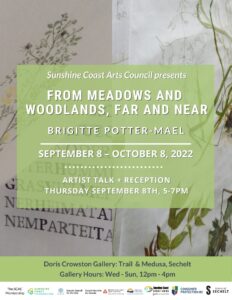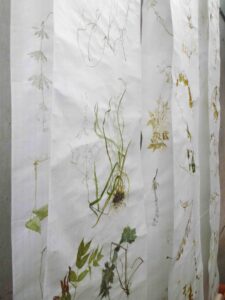September 9 – October 8, 2022
BRIGITTE POTTER-MAEL
From Meadows and Woodlands, Far and Near
Artist Talk and Reception: Thursday September 8th, 5-7pm
Wood-Cut Workshop: Saturday/Sunday October 8/9th, 10-5pm
Many summers ago in 2005, while walking through meadows and forests around the peripheries of my birthplace, Langenau in the Lone Valley region of southern Germany, I was struck by the land’s abundant wild herbaceous plant species. Laid out in front of me were multitudes of plants in bloom and seeing them all mingled together in a side-by-side harmony inspired a memorable moment of enchantment and a vision to create a scroll-work in which these plants would be documented in collaboration with a botanist from eco-systems in the Lone Valley .
I have always appreciated the humble beauty and particular calligraphic forms of wild plants and thanks to my paternal grandparents I had learned quite a bit about edible and medicinal plants, but not having studied botany I wasn’t able to identify them by their names. So I began reading books to get familiarized until I decided to seek contacts with active botanists in Germany and British Columbia . All of this added to my understanding of the notion that plants too have a voice and need to be given agency as stewards of the land who protect the survival of other species… that their existence send vital messages from “the earth’s blanket” (Nancy J. Turner, 2008 ) into the eyes, ears, hearts and minds of human beings; begging us perhaps to realize that “the flower is not inconsequential, the flower is the voice of the land speaking” (Suzi Gablik 1991).
Acting upon my vision, I designed a collaborative project and sent this to the German botanist Dr. Hermann Muhle, active at the Herbarium of the University of Ulm, in 2007. He accepted my invitation and began collecting plant specimens in the spring of 2010. I was thrilled to be able to accompany him on two field trips while visiting Germany and by 2012 I had an entire compendium of 175 botanized plants in my hands. Dr. Muhle had pressed each specimen beautifully; each marked with data that included location, date and plant names in both Latin and German. The moment of joy and gratitude I felt when receiving that precious gift from my birthplace made a lasting impact on me. From start to finish it is only because of Dr. Muhle’s close collaboration, professional guidance and his generous sharing of knowledge that my own hand, with brush and watercolor medium on Mulberry paper scrolls, could find expression in this work. With it I was at last able to build the cultural bridge I had long envisioned between my two homelands. The designing, the building and its completion took five years between the ‘here and there’. It required being in two places at once and it also required that the plants be sent across that imaginary bridge from the Lone Valley to Vancouver in 2014. The botanized plants for this project are now stored away from the light. My scrolls take opportunity to speak in their stead on a public stage today.
Brigitte Potter-Mael studied stone lithography and woodblock printing at the University of Concordia, Montreal, where she graduated in April 1983. Although she has worked in diverse media since then, she has preserved her curiosity in creating printed images throughout the years since then. She was fortunate to have worked in a wide range of printmaking facilities that included Atelier Circulaire in Montreal (1983-88), Grafikwerkstatt Dresden, (1999), Bethanian (BBK) Berlin (2003), Quercus Studio in Italy (2004-2009), Klovtoft, Denmark (2010-2013, and she is still an active member of Malaspina Printmakers, Vancouver, since 1990.
Her work has been shown in solo- and group-exhibitions in Canada, Germany, France, Italy, Portugal, Finland, Poland, Japan and the USA since 1984; it can be found in major public collections such as the Canada Council for the Arts Ottawa, the Ministry of cultural Affairs Quebec, the Camosun College in Victoria, the University of British Columbia, the Malaspina Printmakers Society Archives in Vancouver, the Walter Phillips Gallery in Banff, the Esperanza Gallery and Concordia University in Montreal, the Kulturamt in Dresden, the Pinacoteca Vitulano in Italy, and in many private collections in Canada and abroad.
Her professional development spans over various seminars such as Women, Life and the Planet, Simon Fraser University; the “Social Sculpture” Colloquium (after Joseph Beuys) at Goethe Institute Glasgow; the Banff Centre for the Arts Participant Program and the Leighton Artist Colony in Banff; and in search of medicinal plants at Insula, Biological Reserve, Amazone Peru. She is a recipient of various grants and stipends from Canada Council for the Arts Ottawa; Ministry of cultural Affairs Quebec; Banff Centre for the Arts; Goethe Institute Vancouver; Kulturamt Dresden; Rosa Luxemburg Institute, Berlin; Pinacoteca Vitulano, Italy; Altos de Chavon Artist Colony, Dominican Republic.
- Medicinal Plant Series: Eschscholzia california
- Lone Valley Herbarium





